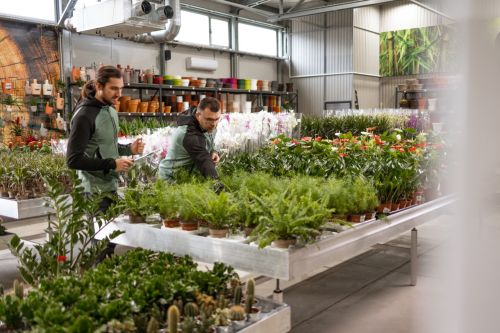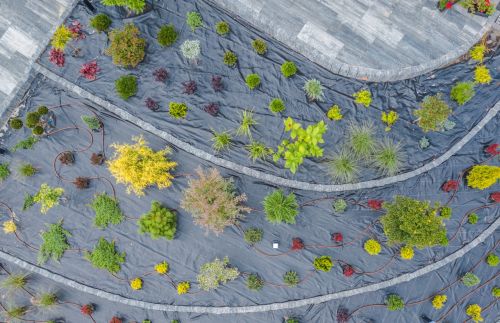Landscape project design and implementation is a comprehensive process aimed at arranging living spaces in an aesthetic, functional, and sustainable manner. It can be applied across a wide range of projects, from standalone residential garden designs to large-scale residential complex arrangements. Garden planning processes require the harmonious integration of landscape plants and hardscape elements. With proper planning and an expert approach, visually impressive and practical landscape areas can be created. In this guide, you will find detailed information on landscape design, implementation, maintenance, and sample projects.

Landscape refers to the art of planning and organizing natural elements, plants, hardscapes, and man-made features in a way that transforms living spaces both aesthetically and functionally. Often, the question “What is landscape?” is mistakenly limited to green space arrangements. However, in reality, landscape design is a comprehensive planning process that considers ecological balance, contributes to environmental sustainability, and enhances spatial efficiency. Therefore, it is not merely visual arrangement but rather the healthy integration of human life, nature, and built environments.
Through a harmonious composition of natural and artificial elements, landscape ensures that living environments meet both visual and practical needs. Whether in gardens, parks, residential complexes, villas, or institutional premises, landscape arrangements fundamentally change the character of a space. Grass areas, ornamental plants, walkways, seating zones, water features, lighting systems, and boundary elements all serve as the building blocks of a well-designed landscape. When these components are positioned in a visually and functionally harmonious manner, they give rise to both eye-catching and livable environments.
The significance of landscape goes far beyond visual appeal. It also plays a critical role in environmental health. Plants improve air quality, prevent soil erosion, and support biodiversity. Especially in detached house garden landscaping, sustainable practices can be used to support environmentally conscious solutions, such as enhancing water absorption through soil and providing natural shading. Moreover, landscape design directly influences social life by creating areas where people can gather, relax, and engage with nature. These environments help reduce stress, encourage psychological well-being, and improve overall quality of life by increasing human interaction with nature.
Another notable benefit of landscaping is its contribution to property value. A professionally designed garden landscape complements a structure’s architectural identity and enhances its visual attractiveness. This is particularly true in villa landscape design examples and residential complex garden projects. A high-quality landscape installation improves the livability of a property while simultaneously increasing its market value. Since first impressions often begin with the exterior, proper landscaping becomes an essential asset in boosting appeal.
In summary, landscaping is essential for establishing nature-friendly living spaces while offering a blend of visual, environmental, and functional benefits. Today, landscape projects play a central role in sustainable urban development, climate-resilient infrastructure, and the creation of communal spaces. The question “What does landscape mean?” can no longer be answered simply as planting grass—it now implies creating livable, practical, and peaceful environments by protecting nature and enriching everyday life.
Landscape is a broad term encompassing the visual and functional arrangements created by combining natural and man-made elements. Derived from the French word “paysage,” landscape refers to the redesigning of nature according to aesthetic, architectural, and ecological principles. In this context, the answer to the question “What is landscape?” includes not only nature itself but also a planned design approach that beautifies and enhances human life. Today, landscape is not limited to parks or large public areas—it has become a significant aesthetic component around houses, residential complexes, villas, and workplaces.
Landscape plays a vital role in preserving natural texture, ensuring visual appeal, regulating microclimates, and improving environmental quality. Especially in garden planning and environmental designs, it is one of the key factors that directly affect individuals’ quality of life.
Landscape design is not merely about beautification; it’s a holistic process that evaluates sustainability, functionality, and harmony with the environment. In detached homes, villas, or residential complex gardens, professional landscaping enhances both the value of the space and the efficient use of natural resources.
Landscape planning contributes to the environment by increasing green space, promoting biodiversity, and enabling responsible water usage. In detached house garden landscaping projects, such design is essential to create outdoor areas that align with the house's architecture. Moreover, a well-planned landscape project offers more functionality with lower long-term maintenance costs.
In our garden landscaping services, Cem Botanik begins with an in-depth analysis of the site’s current condition to identify the correct soil structure and plant species. Lawn implementation is supported by automatic irrigation systems to create long-lasting and healthy green areas. Especially popular in villas, holiday homes, and residential complexes, this service transforms your outdoor space into a more natural and inviting environment.
Hardscape design includes structural elements such as stone pathways, natural stone paving, pergolas, and deck systems. These installations are essential for creating outdoor areas that are not only beautiful but also highly functional. The use of wood and stone in tandem makes hardscaping one of the most durable and elegant solutions among landscape materials.
Each detached house landscape project is custom-designed based on the home’s architecture and user preferences. From large gardens to compact courtyards, various scales of implementation are available. Especially in villa garden landscaping, we integrate components such as natural stone paths, water features, seating zones, and decorative plantings. At Cem Botanik, we deliver personalized landscaping through custom landscape drawings and tailored installations.
The landscape process begins with an on-site assessment and user needs analysis. Natural factors like sunlight exposure, soil type, slope, and wind direction are examined. Simultaneously, lifestyle habits and desired design styles are taken into consideration to form a preliminary plan.
In this phase, landscape design examples are created and shared for client approval. Scaled drawings, 3D visualizations, and material selections are presented. Upon approval, the implementation phase begins.
The approved design is implemented by experienced teams. Both plant-based and structural landscaping components are realized in a fast and controlled manner. Irrigation, drainage, lighting, and lawn installation are completed at this stage. After final delivery, the project enters its warranty and aftercare phase.
In large properties, landscape models often include organic walking paths, fruit trees, natural stone pavements, and resting areas. These spaces are enhanced with landscape lighting systems to ensure usability even at night.
In housing developments, site garden landscaping includes playgrounds, sports areas, walking tracks, and ponds designed for shared use. These spaces are planned with both aesthetics and safety in mind.
For limited outdoor areas, minimalist landscape designs are ideal. Small seating zones, potted plants, vertical gardens, and compact water features offer both functional and aesthetic solutions.
Landscape refers to the planned organization of natural and artificial elements to create visually and functionally balanced outdoor environments. It combines ecological awareness with design and architecture to enrich daily life.
Landscape design is applied in private homes, villas, residential complexes, hotels, commercial buildings, and public parks. Each project is tailored to the location’s size, purpose, and environmental factors.
In detached house landscape projects, the house’s architecture, sun orientation, user needs, and aesthetic preferences are all considered. The goal is to create a seamless connection between indoor living and the garden.
Important considerations include soil quality, drainage, plant compatibility, irrigation planning, lighting systems, and long-term maintenance needs. A well-planned project offers sustainability, efficiency, and beauty.
The cost of a landscape design project depends on the size of the area, the complexity of the design, and the materials used. Custom quotes are provided after site analysis and design proposal.
Landscape lighting extends usability into evening hours and enhances safety. It also highlights key landscape features, adds ambiance, and increases the property’s value and visual impact.
Landscape refers to the arrangement of natural and artificial elements to enhance living spaces in terms of aesthetics, functionality, and ecology. The question "What does landscape mean?" involves more than just visual changes—it also encompasses sustainable environmental design.
Landscaping can be applied across a wide range of environments, from detached home gardens to residential complexes, hotels, and public spaces. Gardens, parks, terraces, and even balconies can be transformed into landscaped areas with proper design.
Detached house landscaping projects are specifically tailored to the location, climate, user needs, and aesthetic expectations of the property. Personalized solutions are offered for each space.
Important considerations include soil analysis, plant selection, water drainage, wind direction, usage habits, and maintenance convenience. The selection of landscape materials is also crucial for durability and visual appeal.
The cost of a landscaping project varies depending on the area size, materials used, plant variety, labor duration, and additional features. A precise quote is typically prepared after an on-site assessment.
Landscape lighting systems enable nighttime use while enhancing safety. Walkways, entrances, and focal points can be highlighted with special lighting to increase both functionality and ambiance.





